Abstract
The fundamental problems with component production in the automotive industry are the low quality of the components, the high number of failures, and the subsequent number of complaints. The quality of automotive components is a prerequisite for automated production in a SMART Factory 4.0 in the context of Industry 4.0. Managing complaints is a critical area in the automotive manufacturing industry. The primary goal of this article is to indicate the significance of a CRM system and the importance of complaints management in automotive manufacturing, which improves the quality of the process of producing components while improving the quality of the inputs—the quality of materials, the quality of the human factor, and the quality of the services provided in connection with the components. (1) A Slovak company was selected as the subject of this research, which focuses on the production of automotive parts. (2) The methods of research focused on using economic analysis and instruments of quality management such as the QRQC method, FMEA method, the Ishikawa diagram, and the Pareto analysis and Lorenz curve. This article presents the results of complaints about automotive components: locksets in vehicles. (3) This research shows the basic cause of the problem: a bent pin after riveting in the process of producing the components. In the frame of this research, we suggested corrective measures to eliminate the actual causes of failure in the production of the components. The RPN index reached a level below the limit of 150 (the critical level of the customers’ requirements) after implementing the corrective measures. The total costs of complaints in this year were calculated to be EUR 13.575 and the costs will be reduced gradually after changes are implemented in the production process. (4) A new complaints information system and a new training center are beneficial for solving problems in the production of automotive components. The implementation of a CRM system and other systems are prerequisites for solving customer complaints.
1. Introduction
The meaning of Factory 4.0 embodies the concept of interconnected and intelligent manufacturing that is focused on the quality of the automotive components entering production processes. The Factory 4.0 solution enables the setup and digitization of operations, connectivity, monitoring, collection, and data analysis. The basic pillars of the intelligent Factory 4.0 strategy are innovation, agility, efficiency, and risk management. These basic pillars of the intelligent Factory 4.0 strategy are also part of complaint management. Problems in the manufacturing of automotive components have always been barriers to suppliers, customers, and the management of companies. Problems with automotive components generate low levels of productivity, poor quality, and high costs and cause the loss of customers. Aichouni et al. (2021) noted that problems with automotive components must be prevented via various innovative methods and by following well-established methodologies of continuous improvement [1]. In the automotive industry, an especially important aspect is the integration of suppliers and customers into the supply chain. Behrens et al. (2007) stated that complaints regarding automotive components must be processed with high urgency and precision by complaint management staff [2].
Aksoy, Yilmaz (2022) noted that a sustainable advantage in competitiveness is orientated toward customers. Companies must place the customer at the center of all activities. Companies must create customer loyalty by offering products and services and providing customer satisfaction. A key element of ensuring customer satisfaction is the effective handling of customer complaints [3]. Phanden et al. (2022) stated that satisfaction is defined by customers expressing their dissatisfaction with unmet expectations and unsatisfied needs verbally or in writing [4].
Problem-solving techniques influence operational efficiencies, reduce the wastage of materials, improve production consistency, increase performance, improve the cycle time in production, and increase financial sources [4]. Currently, production processes in the automotive industry and, especially in the field of automotive components and parts, are highly controlled in terms of output quality, and changes in the requirements of buyers of automotive components and parts are occurring at a faster pace. Successfully handling the production process of automotive components is necessary to focus on the management of complaints. Complaints affect the quality of production and reduce customer satisfaction due to poor quality.
The main goal of this contribution is to emphasize the importance of the implementation of claims management and all modern instruments in automotive manufacturing, which improves the quality of the production process of components and, at the same time, improves the quality of inputs—the quality of materials, the quality of the human factor, and the quality of services.
This research was realized in a Slovak production company which focuses on the production of automotive components and has a significant market share in the automotive industry. As part of this research, we set research questions aimed at resolving complaints about automotive parts from the supplier. The research questions were defined as follows:
RQ1: Which automotive parts from the product portfolio are critical for customers?
RQ2: How many complaints were recorded for the critical component?
RQ3: What are the basic causes of poor quality of critical components?
RQ4: Which factors significantly influence output?
RQ5: What will make it possible to track complaints resolution more effectively?
RQ6: What means can be used to improve the quality of automotive components?
The research questions were consequently analyzed in this article. The company offers automotive components for a wide market of customers, and the highest share of its automotive components is purchased by automotive companies such as Renault (23%), Volkswagen (16%), and Peugeot (13%). Important customers also include the automotive companies Toyota, BMW, Ford, Nissan, and others (Figure 1). The policy of quality improvement in the production of automotive components plays a critical role in the production and the satisfaction of customers. The Global 8D methodology is an innovative method in Industry 4.0 and is used in various production processes. This method, Global 8D, solves all chronic problems [5]. Global 8D is a disciplined process used to identify and solve problems with respect to “root causes”. This method influences customer satisfaction issues and helps reduce warranty costs.
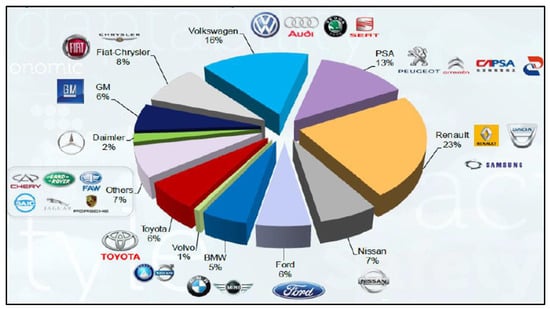
Figure 1.
Market share of automotive companies—customer portfolio. Internal documents.
2. Literature Review
Increasing and improving the quality of automotive components production in the automotive industry is based on an integrated management system. This integrated system includes a quality system according to ISO 9001:2016, an environmental management system ISO 14001:2016, and a system of occupational health and safety according to ISO 45001:2019. Sourdin et al. (2021) noted that effective complaint management offers a range of benefits, providing relationships with suppliers and customers, lower costs, and the opportunity for service process improvements. These benefits bring a return on investment (ROI) for companies and advantages in the financial area [6]. Ngai et al. (2007), said a complaint is a negative expression of a restless customer or consumer, about the product, services, and organization’s action [7]. According to Tronvoll (2007), it is an action taken by a restless individual, that involves communicating something unwanted or unacceptable regarding a product or service [8]. The complaints are proof of customer dissatisfaction with the products and services. A simple definition of a complaint is ‘it is a statement that something is unsatisfactory or unacceptable’ by Oxford Dictionaries. Complaint management is the process by which companies systematically handle the problems of customers. According to Hansen et al. (2010), it involves receiving, inquiring, resolving, and preventing customer complaints [9]. This phenomenon is critical because complaints have never been taken positively. The companies do not register the complaints; therefore, this causes more dissatisfaction among customers. An effective complaint management system is a necessity [10]. Managing complaints is a critical activity for various industries. Complaint management is the priority area of the concept of Industry 4.0 in the frame of digitalization, quality, and optimization. The primary purpose of effective complaint management systems is to increase profits by increasing revenues and reducing costs, and using intelligent management systems such as CRM systems (Customer Relationship Management) [11].
The complaints introduce correct consequences that improve financial performance by satisfying customers or employees and improving products, processes, and inputs [12]. Financial benefit creates added value for the company. An effective complaint process may be excellent for staff and customers [13]. To generate maximum benefit from complaints means to have effective complaint management processes to focus on improvement [14]. A model of customer complaint management is developed in terms of marketing strategy. Based on micro factors, firms’ incentives to manage the complaints of customers are analyzed [15]. Innovative techniques for solving complaints have impacts on companies. Those techniques increase operational efficiencies, reduce material wastage, improve the consistency in production, increase production performance, improve the manufacturing cycle time, and ultimately increase the profit [16]. Managerial instruments and application of the Plan-Do-Check-Act cycle (PDCA) with 8D help to achieve reliable solutions and increase the quality of the production processes [4]. Mediated by customer satisfaction, the brand image is a factor that influences the purchase decision [17]. The other managerial implication is that the automotive industry should manage product quality and communicate that aspect with the customers to solve problems with quality [18]. The quality of the automotive components plays a significant role in the reliability of the vehicles, reputation, customer loyalty, and in cost of warranty services [19]. The economics of vehicle quality are solved by a preventive improvement strategy of the key components [20]. Automotive companies ignore the operational value of complaints. The complaint processes are geared toward mollifying customers rather than ensuring that problems do not reoccur [21]. Financial performance and complaints are connected. Important factors are satisfaction, retention of customers, process improvement, employee attitude, and employee retention [22]. In the praxis, several factors have been identified for effective complaint management. These include having clear procedures; providing a speedy response; the reliability (consistency) of response; having a single point of contact for complainants; and ease of access to the complaints process [23].
The performance evaluation depends on the ease of use of the process that evaluates the complaints of customers [24]. The complaints achievement evaluation is orientated to information of the complainant; the staff understands the complaint processes, the complaints are taken seriously, employees are empowered to deal with the situation, and follow-up procedures to check with customers after resolution [25].
In today’s stage of permanent changes, a factor is the costs incurred for the implementation changes due to the emergence of low-quality products and complaints. The most urgent task of today’s innovative companies is the time lessens and costs for change implementation. Complaints management deals with the quality of products pillar, the satisfaction of customers, and the optimization of costs. Quality management system involves solving complaints.
Complaints management means the improvement of the overall management of the companies. An effective complaints management system brings higher productivity, a stronger focus on the customer’s goals and expectations, achieving and maintaining the required quality of the delivered product, building a corporate culture, and reducing the cost of non-compliance.
3. Materials and Methods
The main object of investigation in research was a company operating in the automotive industry. This company focuses on automotive components production. Information resources were drawn from technical documentation, internal documents, and statements of financial accounting. The production company operates in Mexico, Brazil, America, Japan, Malaysia, Thailand, India, China, Russia, and Europe; therefore, it is considered a significant company in the area of producing automotive components in the automotive industry (Figure 2). The production company manufactures automotive components for 15 countries.

Figure 2.
Worldwide divisions of the parent company. Internal documents.
The product portfolio (Figure 3) creates access mechanisms—locksets, latches, and handles. This portfolio represents automotive components that are the object of complaints. Automotive components are critical components. Those components create the base of complaint problems and financial problems. The disadvantages are cost problems, loss of customers, and decreasing quality of automotive components.

Figure 3.
Product portfolio of the company—automotive components. Internal documents.
The company’s product portfolio consists of access mechanisms, starting locks, and keys—locksets, latches, and handles. The basic problem in the company is complaints about these components and especially about the door locks on the vehicle, which cannot be closed under normal conditions. This production process was analyzed, and we investigated the causes of defective components.
The analyze the defective components, we used quantitative methods of the QMS system such as QRQC analysis, Ishikawa diagram, Pareto analysis, FMEA, economic analysis, number of complaints, graphical row graph, and others.
The Ishikawa diagram is a “fishbone” diagram used to show the relationship between problems and possible causes of their occurrence. The principal axis represents the problem. The ribs of the spine are created by individual causes. When solving product quality problems, the following main categories are used: 5M, 6M, or 7M (Material, Machinery, Men, Methods, Measurements, Management, and Mother Nature). The Ishikawa diagram procedure consists of the steps—the problem is represented in the head of the fish, it is necessary to draw the spine and ribs, and the diagram is continued by asking the question “Why?” for each cause of the problem, identifying the root causes using a diagram, and proposing measures to eliminate the root causes. Quick Response Quality Control (QRQC) is a method used in all processes that are defined between individual internal or external customers. The first step is to define the problem through the 5W2H approach. The second step is to determine immediate corrective measures. The next step is the search and analysis of all possible factors of the problem and learning from the problem for the future (Figure 4).

Figure 4.
QRQC algorithm for solving problems of automotive components. Own source.
The Pareto diagram is a regularity that can be observed in various areas of industrial activity. The Pareto principle explains that approximately 20% of the causes cause up to 80% of the effects. The Pareto diagram is the base part of the Pareto analysis, which consists of the detections and their frequency. A Pareto chart is a graphical scheme of the detection of the product. Types of detection are shown on the horizontal axis and the cumulative frequency of detection on the vertical axis.The subject of the FMEA method is the analysis of errors and their consequences to propose corrective measures that eliminate existing or potential errors. The advantage of FMEA is that it can be applied not only to production processes and products but also to services (financial, social, and others). The result of the FMEA is the adoption of effective corrective measures that will reduce the risk that the occurrence of an error brings with it. The determined risk number (RPN) links the meaning of the error, the probability of the error occurrence, and the probability of the error detection. In the selected company, the critical RPN number was determined by customers. RPN number means occurrence/severity/detection was 5/5/6, and RPN = 150. Therefore, we consider values above RPN = 150 as a critical error, the range between RPN = 101–149 as a marginal error, and RPN ≤ 80 less than 80 as a negligible error. This makes it possible to compare individual errors and focus on the causes that cause the error to occur.
4. Results
The research was focused on the complaints process due to customer dissatisfaction with low-quality automotive components. The object was an automotive company in Slovakia that deals with automotive components production. The entire research was orientated on finding out the critical cause of low-quality automotive components and finding solutions that would benefit customers. In this research, we wanted to answer the research questions:
RQ1: Which automotive parts from the product portfolio are critical for customers?
RQ2: How many complaints were recorded for the critical component?
RQ3: What are the causes of poor quality of critical components?
RQ4: Which factors significantly influence output?
RQ5: What will make it possible to track complaints and their resolution more effectively?
RQ6: What means can be used to improve the quality of automotive parts?
These research questions were solved step by step.
The entire research on solving the problem with automotive components—the door lock was based on the methodology of quality tools (Figure 5).
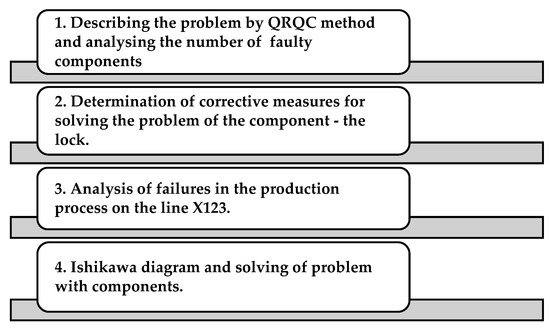
Figure 5.
Algorithm of research of the problem with automotive components. Own source.
We used the QRQC (Quick Response Quality Control) method to detect low-quality products by a customer in the first step of the research. We obtained the answer to the first question: RQ1: Which automotive parts from the product portfolio are critical for customers? The critical portfolio was locks, handles, and latches.
We analyze the number of faulty components (NOK). We obtained the answer to the second question: RQ2: How many complaints were recorded for the critical component? Critical components from the year 2018 were eighteen, whilst in the year 2023, there are now nine critical components (Figure 6).
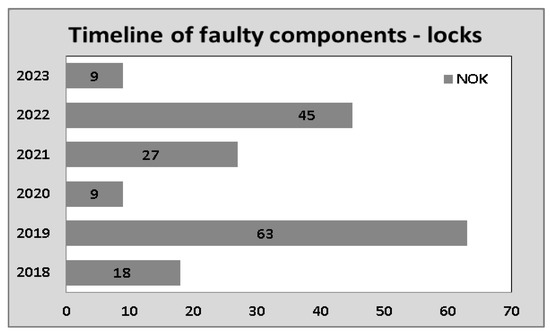
Figure 6.
Number of detected low-quality automotive components. Own source.
Due to finding mismatched pieces at the customer’s place, it was necessary to implement immediate corrective measures (Quick Response) to continue production. The problem is the lockset, i.e., closing the door. This problem was identified on the final line at the customer. This problem is based on the function test of the lockset. Based on this, a QRQC team was established, the members of which were process engineers, quality engineers, quality technicians, and the manager of the department under which the production line belongs, and this team solved the problem with the lockset. Due to the high penalties for non-delivery of the component, the cause and its solution are a priority. The error in the lockset was proven (Figure 7).
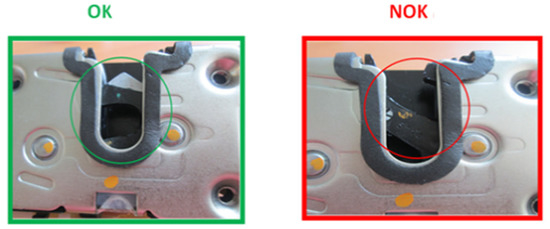
Figure 7.
The right product (OK) and the wrong product (NOK). Own source.
In the second step of the research, we determined corrective measures for solving the problem of the component—the lock. The corrective measures are: blocking the manufactured locks that were ready to be sent to the customer, organizing an internal sorting of the faulty locks using 100% manual lock inspection, starting sorting of the locks that the customer has in stock, placing a visual aid on the production line, and then, retraining the operators on the occurrence of an error.
In the third step of the research, we analyzed the failures of automotive components in production (Figure 8). It was the answer to the question: RQ3: What are the main causes of poor quality of critical components? By this Pareto analysis was recorded the major causes of poor quality of the automotive components. The occurrence of the most frequent failures on production line X123 recorded the most frequently occurring error—the problem of a bent pin after riveting. The other failures represented incorrect riveting height, incorrect riveting speed, improperly installed spring, electrical failure, and a not connected switch. Complaints management and the solution of low-quality products—components at the customer’s place are a basic prerequisite for retaining the customer and not damaging the good name of the manufacturing company in the automotive industry. We found out in the research which is the most common reason for complaints and which errors represent poor quality output for the customer.
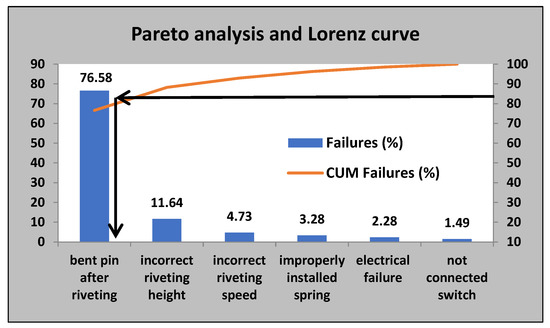
Figure 8.
Pareto analysis of failures in the production. Own source.
Based on the Pareto analysis, we can conclude that the priority problem on the X123 line is the bent pin after riveting. The percentage expression of this error is 77%, which is the highest share. This failure becomes the basis for finding improvement solutions. The Lorenz curve is based on accumulated error rate data and expresses the number of failures in the 80/20 ratio. At the 80 (%) level, the straight line intersects the Lorenz curve, and the vertical to the (x) axis establishes the priority failures of components in production. Those failures must be addressed to generate economic losses and the loss of customers. In this research for the selected company is the priority error in the production bent pin after riveting. In the fourth step, we prepare an Ishikawa diagram (Figure 9) to identify the causes of the problem and look for solutions to the problem. In this step, we analyzed the answer to research question RQ4: Which factors significantly influence the output? The 5 M factors influenced the automotive components.
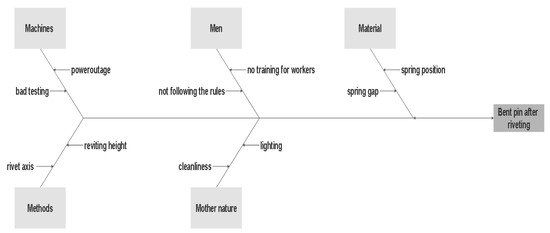
Figure 9.
Ishikawa diagram for problem in the production. Own source.
On the base of the Ishikawa diagram, we identify the failures of the problem (Figure 8) in the production at the line X123. Based on the analysis of the causes of the main problem, we determined the causes that need to be eliminated and proposed corrective measures according to the 5M category. These causes were physically checked, and control points established, which are shown in Figure 10.

Figure 10.
Base causes of problem bent pin after riveting. Own source.
Corrective measures eliminate existing or potential errors in the production process and are a tool for solving problems and subsequent complaints from customers. It is the answer to question RQ5: What will make it possible to track complaints more effectively? Corrective measures for the identified causes were defined as follows and implemented in the production process:
1M—changing the dimensions of the rivet nests;
2M—riveting height control after five products;
3M—introduction of a training center;
4M—determining the position of the springs based on the project documentation;
5M—established preventive maintenance of the rivet nest.
Based on the identification of the causes according to the Ishikawa diagram, corrective measures were determined and implemented, which we followed by an FMEA analysis (Table 1) using the risk measure point, which represented a critical value of RPN = 150 according to customer requirements. The critical value RPN (150) was calculated by the factors of occurrence, severity, detection of potential causes of failure, and mathematical multiplication. RPN values above 150 represent critical errors that need to be addressed. After applying corrective measures, we evaluated the significance, occurrence, and detectability of errors and calculated the value of RPN, which was then again compared with the critical value of RPN = 150. Corrective measures were implemented in the production process:

Table 1.
FMEA results of the corrective measures.
RPN index—the occurrence, severity, and detection shown in Table 1 count multiplication of the factors and it determines the number of RPN.
By applying corrective measures that ensured the pin bending stopped after riveting, it was possible to reduce the number of non-conforming products, which led to increased production efficiency, a reduction in the creation of non-conforming pieces, and speeding up the process of final testing of locks on the X123 line.
5. Discussion
The complaint management system is a priority goal of the strategic management of low-quality outputs but there are also complaints about automotive components in the automotive industry. Pekarčíková et al. (2019) noted that digitalization effects with the rapid accumulation of information, development of technologies, and the processes’ intellectualization pose global challenges for future production in the automotive industry [26]. The answer to the research question: RQ6: What can be used to improve the quality of automotive components production? The management of complaints and the solution of low-quality products—components at the customer’s place are a prerequisite for retaining the customer and not damaging the reputation. Because there were repeated complaints in the manufacturing company in the automotive industry, it was necessary to introduce a system for effective management of complaints. Constant improvement of processes, which is also the process of complaints, plays a role in competitiveness. The company focused on the information system for complaints registration (Figure 11), which was introduced and minimized.

Figure 11.
Implemented incident management system. Internal source.
The complaint management system monitors the condition of the complaints on the timeline. The state of the complaint is displayed graphically using identifiers:
Green point—the complaint is being resolved.
Orange point—the complaint is awaiting approval.
Redpoint —the complaint has a delayed status or is rejected.
According to the company’s standard, the processing complaint time.
Quick Response: 24 h after receipt of the complaint.
Plan Do: 7 days after receipt of the complaint.
Check Act: 14 days after receipt of the complaint.
Closure: 30 days after receipt of the complaint.
An indicator of the complaints process is the complaint time. Every customer making a complaint expects the supplier to resolve it in the shortest time. The set period for closing a complaint was 30 days (Figure 12).

Figure 12.
Solving the complaints in a time interval. Internal source.
This term depends on the type of complaint. It must be included in the contract with the customer. This 30-day deadline has to be observed and monitored. Monitoring is carried out by creating a graph every month. The diagram presents complaints CLM008989-CLM009371 (title, number), the number of days of solving complaints, and the limited time of complaints is 30 days (red color). The quality technician is responsible for this task. Based on the processed complaints and their resolution, we can conclude that the resolution of the complaint is approaching the target value of 30 days.
Makarova et al. (2019) noted that the new conditions require education to train creative people who are capable of solving complex problems using innovative tools [27]. Computer models, construction sets, and simulators allow the employee to solidify knowledge and gain skills in its practical implementation in situations that simulate reality. In addition to professional skills formation, computer simulators successfully develop creativity, professional intuition, and teamwork skills. All of this allows for a significant improvement to the quality of the production process [27]. Corrective measures for the identified causes were defined and implemented in the production process: 3M introduction of a training center (Figure 13).
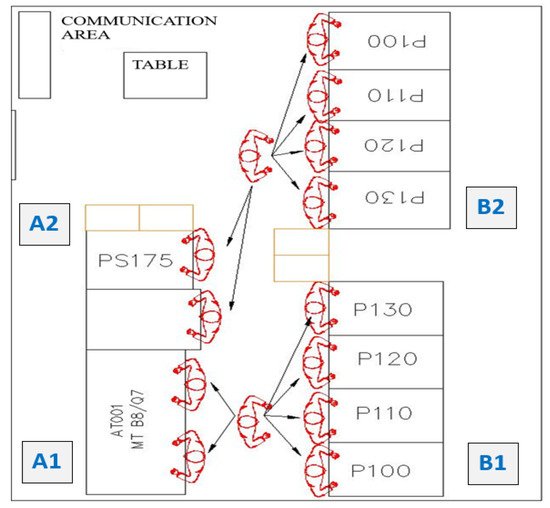
Figure 13.
Training center. Own source.
We analyzed the shortcomings of employees in the area of complaints and their impact on complaints. As an innovative change, it was inevitable to design and implement training centers. These centers have to help new employees who will be hired for the position of production line operator. After the implementation of all formalities, basic training on the production process and the transfer of employees to the training center will follow. The training center will consist of two pre-production lines (A1, A2) and two production lines (B1, B2), each of which contains four production stations—P100 to P130. In the training center, two employees will be able to be trained. The main tasks of trainers will include the following activities: familiarization of new operators of the production line with standards, preparing operators during the entire training in the training center so that they successfully pass the final assessmentinvolving the entire team and interactivity of participants, leading training participants to active participation, and noting the manual skills of individual participants in order to be able to recommend them to production for specific products. The trainer must not use foreign words or abbreviations without explaining them, and the trainer must realize that new workers do not know the company’s standards, so he must explain them and keep repeating them.
Every day, it will be necessary to hand out the relevant cards to the operators and familiarize them with general instructions that describe the individual topics trained on that day. The training will last 5 days. The first 4 days will take place in 3 h blocks, and the last day will take place as follows: 1.5 h—repetition of knowledge from the previous days, testing in the form of a knowledge test—evaluations from the testing will be recorded in the “Operators Training Center” file, which will be accessible to supervisors of individual departments, direct superiors and the company’s HR department.
After the end of the training process, all employees who have successfully completed the TC will be divided into individual production or pre-production lines according to the results of the evaluation from the training center. We assume that the introduction of the training center will significantly contribute to reducing the occurrence of complaints due to the failure of the human factor, which ultimately has a significant impact on reducing the costs of poor quality. Corrective measures implemented in the production process (Figure 14): 1M—changing the dimensions of the rivet nest, 2M—riveting height control after 5 products, 5M—establishing preventive maintenance of the rivet nest. The red line in Figure 14 defines the new dimensions of the rivet nest, the height of the rivet nest, and the angle for a nest of rivets.
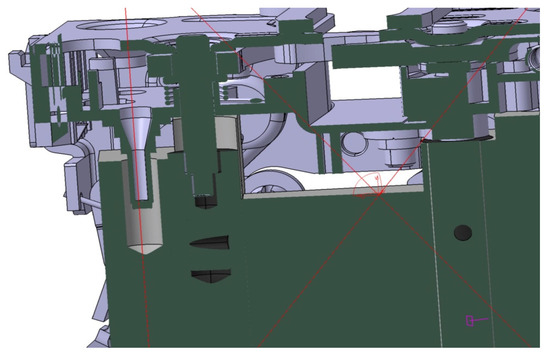
Figure 14.
Preventive maintenance of the rivet nest. Own source.
The overall quality is a prerequisite for meeting the expectations of the company’s customers, developing business, and ensuring growth. An important role in improving quality is played by prevention and control, which is carried out through internal quality audits in the process of preventive maintenance of lines. Internal audits make it possible to remove and verify the effectiveness of the corrective measures taken.
As part of the research, we evaluated the consequences of the total claim in 2023 from an economic point of view as follows (Table 2).

Table 2.
Amount of complaints costs.
The overall process of the complaint to Romania was implemented on the basis of communication with the customer and after the implementation of corrective measures. In addition to technological, technical, and personnel deficiencies, economic costs in the production company were also recorded. The cost of the claimed door locks reached the level of EUR 13.575.
The general recommendations for the automotive components manufacturing industry:
- Review customer requirements for specific components.
- Check the production of components with valid documentation and design.
- Perform an incoming inspection of materials for the production of components.
- Continuously control the production of components in individual phases.
- Regularly inspect and train employees at the production lines.
- Perform preventive maintenance of machines.
6. Conclusions
For effective complaints management, necessary factors to consider include satisfaction, retention of customers, process improvement, retention of employees, quality outputs, communication with customers, reducing failures of the products, looking for causes of complaints, and others. Problems in automotive components manufacturing have always been barriers to customers but also the management of the company. Automotive component failures lead to low productivity, low quality, high costs, and loss of customers. Complaints management is a priority area of the Industry 4.0 concept within the pillars—digitization, quality, and optimization. The priority goal was to present the importance of complaint management in the automotive industry because automotive components create part of production and influence the quality of products. The object of the research was a company that focuses on automotive component production as locks, handles, and latches. As part of the algorithm of steps, we proceeded as follows: description of the problem using the QRQC method and analysis of the number of defective components, determination of corrective measures to solve the problem of the parts—lock, analysis of production failures on the X123 line, creation of an Ishikawa diagram and solution of the problem with the automotive parts. This article presents the results of complaints about components—locks in vehicles. In the research, we found the priority cause of the problem—a bent pin after riveting in the production process. In this research, corrective measures were proposed to eliminate the existing causes in production: 1M—changing the dimensions of the rivet nest, 2M—checking the riveting height after five products, 3M—introducing a training center, 4M—determining the position of the spring rivet based on the project documentation, 5M— preventive maintenance of the rivet nest. A training center has been established to minimize human factor errors in automotive components production. The total cost of complaints this year was EUR 13,575. These costs would gradually decrease until the end of the year. The new information system for complaints is beneficial for solving problems in the automotive industry and allows monitoring time intervals for handling customer complaints. The first strategic vision for automotive companies is the significance of using, implementing, and improving the CRM—customer relationships system. CRM system is a form for managing all company’s relationships and interactions with customers and potential customers. CRM system helps companies stay connected to customers, streamline processes, and improve profitability.
Author Contributions
Conceptualization, K.T., S.K., T.M. and M.F.; methodology, K.T.; formal analysis, K.T.; resources, S.K., T.M. and M.F.; data curation, S.K., T.M. and M.F.; writing—original draft preparation, K.T.; visualization, K.T.; project administration, S.K.; funding acquisition, S.K. All authors have read and agreed to the published version of the manuscript.
Funding
This research was funded by project KEGA 010TUKE-4/2023.
Acknowledgments
This article is part of project KEGA 010TUKE-4/2023—Application of educational robots in the process of teaching the study program industrial logistics.
Conflicts of Interest
The authors declare no conflict of interest.
References
- Aichouni, A.B.E.; Ramlie, F.; Abdullah, H. Process improvement methodology selection in manufacturing: A literature review perspective. Int. J. Adv. Appl. Sci. 2021, 8, 12–20. [Google Scholar] [CrossRef]
- Behrens, B.-A.; Wilde, I.; Hoffmann, M. Complaint management using the extended 8D-method along the automotive supply chain. Prod. Eng. 2007, 1, 91–95. [Google Scholar] [CrossRef]
- Aksoy, M.; Yilmaz, O. Consumer complaints and complaint management in tme tourism sector. Contemp. Stud. Econ. Financ. Anal. 2021, 108, 95–111. [Google Scholar] [CrossRef]
- Phanden, R.K.; Sheokand, A.; Goyal, K.K.; Gahlot, P.; Demir, H.I. 8Ds method of problem solving within automotive industry: Tools used and comparison with DMAIC. Mater. Today Proc. 2022, 65, 3266–3272. [Google Scholar] [CrossRef]
- Divanoğlu, S.U.; Taş, U. Application of 8D methodology: An approach to reduce failures in automotive industry. Eng. Fail. Anal. 2022, 134, 106019. [Google Scholar] [CrossRef]
- Sourdin, T.; Carlson, J.; Watts, M.; Armstrong, C.; Carlyle, T.; McGeoch, D. Measuring effective complaint handling by government. Australas. Disput. Resolut. J. 2021, 31, 210–222. [Google Scholar]
- Ngai, E.W.; Heung, V.C.; Wong, Y.; Chan, F.K. Consumer complaint behaviour of Asians and non-Asians about hotel services. Eur. J. Mark. 2007, 41, 1375–1391. [Google Scholar] [CrossRef]
- Tronvoll, B. Customer complaint behaviour from the perspective of the service-dominant logic of marketing. Manag. Serv. Qual. Int. J. 2007, 17, 601–620. [Google Scholar] [CrossRef]
- Hansen, T.; Wilke, R.; Zaichkowsky, J. Managing consumer complaints: Differences and similarities among heterogeneous retailers. Int. J. Retail. Distrib. Manag. 2010, 38, 6–23. [Google Scholar] [CrossRef]
- Stauss, B.; Seidel, W. Effective Complaint Management; Springer Publication: Berlin/Heidelberg, Germany, 2019. [Google Scholar]
- Markulik, S.; Turisova, R.; Nagyova, A.; Vilinsky, T.; Kozel, R.; Vaskovicova, K. Production Process Optimization by Reducing Downtime and Minimization of Costs. Adv. Phys. Soc. Occup. Ergon. 2021, 273, 220–227. [Google Scholar] [CrossRef]
- Potkány, M.; Gejdoš, P.; Lesníková, P.; Schmidtová, J. Influence of Quality Management Practices on the Business Performance of Slovak Manufacturing Enterprises. Acta Polytech. Hung. 2020, 17, 161–180. [Google Scholar] [CrossRef]
- Potkany, M.; Zavadsky, J.; Hlawiczka, R.; Gajdos, P.; Schmidtova, J. Quality Management Practices in Manufacturing Enterprises in the Context of Their Performance. J. Compet. 2022, 14, 97–115. [Google Scholar] [CrossRef]
- Stone, M. Literature review on complaints management. J. Database Mark. Cust. Strat. Manag. 2011, 18, 108–122. [Google Scholar] [CrossRef]
- Kumar, A.; Kaur, A. Complaint management-review and additional insights. Int. J. Sci. Technol. Res. 2020, 9, 1501–1509. [Google Scholar]
- Cehlár, M.; Čulková, K.; Pavolová, H.; Khouri, S. Sustainability of Business with Earth Sources in V4. In Proceedings of the 4th International Innovative Mining Symposium, Montreal, QC, Canada, 21 June 2019; E3S Web of Conferences. Edition Diffusion Presse Sciences: Bristol, UK, 2019; Volume 105, pp. 1–7. [Google Scholar] [CrossRef]
- Suchánek, P.; Richter, J.; Králová, M. Customer Satisfaction, Product Quality and Performance of Companies. Rev. Econ. Perspect. 2015, 14, 329–344. [Google Scholar] [CrossRef]
- Waluya, A.I.; Iqbal, M.A.; Indradewa, R. How product quality, brand image, and customer satisfaction affect the purchase decisions of Indonesian automotive customers. Int. J. Serv. Econ. Manag. 2019, 10, 177–193. [Google Scholar] [CrossRef]
- Zhou, F.; Wang, X.; Goh, M.; Zhou, L.; He, Y. Supplier portfolio of key outsourcing parts selection using a two-stage decision making framework for Chinese domestic auto-maker. Comput. Ind. Eng. 2019, 128, 559–575. [Google Scholar] [CrossRef]
- Lachvajderová, L.; Kádárová, J. Industry 4.0 Implementation and Industry 5.0 Readiness in Industrial Enterprises. Manag. Prod. Eng. Rev. 2022, 13, 2387. [Google Scholar] [CrossRef]
- Markulik, Š.; Petrík, J.; Šolc, M.; Blaško, P.; Palfy, P.; Sütőová, A.; Girmanová, L. Analysis of Fault Conditions in the Production of Prestressed Concrete Sleepers. Appl. Sci. 2022, 12, 928. [Google Scholar] [CrossRef]
- Carlson, J.; Sourdin, T.; Armstrong, C.; Watts, M.; Carlyle, T. Return on Investment of Complaint Management: A Review and Research Agenda. Australas. Mark. J. 2022. [Google Scholar] [CrossRef]
- DiCarlo, M.; Berglund, E.Z.; Kaza, N.; Grieshop, A.; Shealy, L.; Behr, A. Customer complaint management and smart technology adoption by community water systems. Util. Policy 2023, 80, 101465. [Google Scholar] [CrossRef]
- Darmawan, T.S.; Suzianti, A. Knowledge Management Framework in New Product Development Projects of Automotive Industries. In Proceedings of the 3rd Asia Pacific Conference on Research in Industrial and Systems Engineering, Online, 16 June 2020; pp. 25–29. [Google Scholar] [CrossRef]
- Dumitrascu, O.; Dumitrascu, M.; Dobrotǎ, D. Performance Evaluation for a Sustainable Supply Chain Management System in the Automotive Industry Using Artificial Intelligence. Processes 2020, 8, 1384. [Google Scholar] [CrossRef]
- Pekarčíková, M.; Trebuňa, P.; Kliment, M. Digitalization effects on the usability of lean tools. Acta Logist. 2019, 6, 9–13. [Google Scholar] [CrossRef]
- Makarova, I.; Shubenkova, K.; Antov, D.; Pashkevich, A. Digitalization of engineering education: From eLearning to smart education. In Proceedings of the Smart Industry & Smart Education: Proceedings of the 15th International Conference on Remote Engineering and Virtual Instrumentation, Duesseldorf, Germany, 21–23 March 2018; Volume 15, pp. 32–41. [Google Scholar]
Disclaimer/Publisher’s Note: The statements, opinions and data contained in all publications are solely those of the individual author(s) and contributor(s) and not of MDPI and/or the editor(s). MDPI and/or the editor(s) disclaim responsibility for any injury to people or property resulting from any ideas, methods, instructions or products referred to in the content. |
© 2023 by the authors. Licensee MDPI, Basel, Switzerland. This article is an open access article distributed under the terms and conditions of the Creative Commons Attribution (CC BY) license (https://creativecommons.org/licenses/by/4.0/).